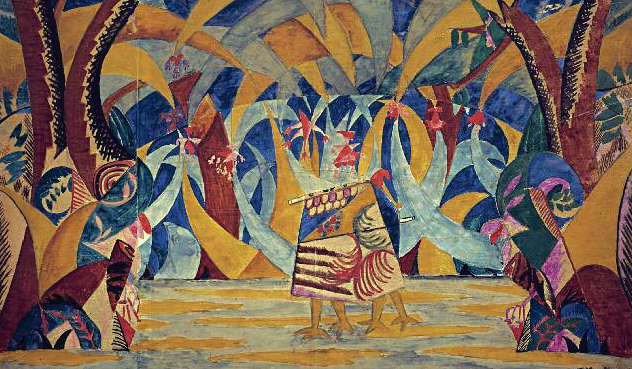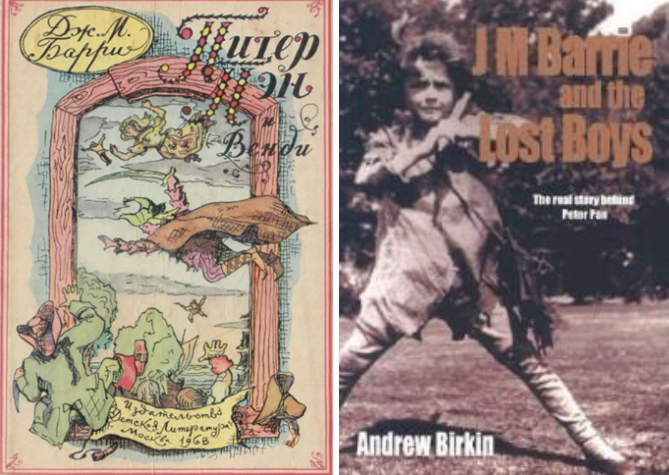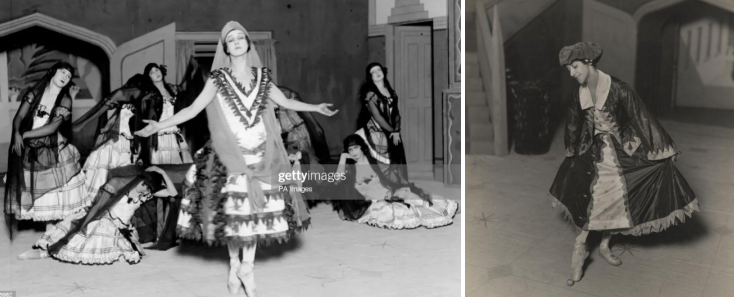 [1]
[1]
By John Helmer, Moscow
@bears_with [2]
Once upon a time, one of the leading literary figures in the UK defended Russian culture by staging a play in a London theatre in 1920 and again in 1926. J.M. (James) Barrie, famous then and now as the creator of Peter Pan, was the playwright; the play he wrote was called “The Truth about Russian Dancers”.
Not one Englishman or Scotsman (for that was Barrie’s race) dares to do such a thing today.
Barrie’s play followed after the Bolshevik Revolution of 1917 and the attempts by the British government in military operations, economic sanctions, and propaganda to attack the new Kremlin regime, kill Vladimir Lenin, and replace the Red government. These military operations didn’t end until the British army withdrew from Russia in September 1920 [3], five months after Barrie’s play had concluded its popular stage run.
According to his script, the fantasy and beauty Barrie characterised as the Russianness of Karissima, the heroine of the play, and her company of dancers is pitted against the unimaginativeness and rigid conformity of the British. And so it is today – that is, if you believe in Barrie, Peter Pan, and their lost boys.
Very well known in Russia as a prima ballerina in her time, Tamara Karsavina, played Karissima, the lead in Barrie’s play “The Truth about Russian Dancers”, but the play itself was not noticed in Russia at the time; it was subsequently forgotten in England. It was rediscovered in English by Olga Soboleva in an academic publication in 2015. This was picked up in Russian in 2019 [4].
Peter Pan first appeared in Russian translation in 1918, after Lenin had begun to consolidate his power and the tsar had been executed. It was fifty years before a second translation was published by a Soviet house in 1968; a third followed in 1981. Since the end of the Soviet Union, there have been twelve fresh translations [5]. The 1981 translation by Irina Tokmakova can still be purchased here [6].
A lengthy history of Russian as well as Soviet interpretations of Barrie’s creation of Peter Pan and its meaning appeared in 2017. It was written by Alexandra Borisenko, a professor of philology and specialist in English literature at Moscow State University. She understood that Barrie was writing autobiographically; that the Peter Pan story was much more than a fantasy; and that the character had appeared many times in Barrie’s work before Peter Pan was named and became famous. “He experienced many losses and tragedies, and this wound permeates almost all of Barrie’s texts, including the tale of Peter Pan.”
Mistaken as a fairy tale for children, Barrie had written his story for adults about children; that’s to say, the loss of children. “Barrie was thinking about childhood all his life,” Borisenko concluded [7], “and constantly returned to this topic in his work: the eternal childhood of those who died before they could grow up; the eternal childhood of those who cannot grow up; eternal childhood as a refuge and as a trap.”
“Ridiculous Barrie-ness”, wrote the book critic at The Times in praise of an earlier version of this theme published in 1902. “Utterly impossible, yet absolutely real, a fairy tower built on the eternal truth… Mr Barrie has given us the best of himself, and we can think of no higher praise.”
“Peter Pan,” Borisenko wrote, “came to Soviet children’s literature relatively late, in the 1960s. For quite a long time the fairy tale in the Soviet Union remained under suspicion — it was believed that unbridled fantasies were harmful to children. Peter Pan was discovered for the Soviet reader almost simultaneously (and independently of each other) by two of the best translators of English children’s classics, Boris Zahoder and Nina Demurova. Boris Zahoder translated the play — at first his translation was staged by MTYUZ [Moscow Young Viewers’ Theatre], then in 1971 he came out with Barrie’s book. As always, Zahoder translated quite freely, with great passion and sensitivity to the text.”
“In the preface, he explains the freedom of handling the text with the interests of the addressee –the child: the translator tried to be as close to the original as possible, more precisely: to be as faithful to him as possible. And where he allowed himself small ‘liberties’ — these were liberties caused by the desire to be faithful to the author and be understandable to today’s young! — to the viewer. The first translation of the story ‘Peter Pan and Wendy’ had to lie in the desk drawer for ten years. Nina Demurova saw the English ‘Peter Pan’ in the early sixties in India, where she worked as a translator. She liked the illustrations by Mabel Lucy Atwell, so she bought a book and sat down to translate it. It was her first translation experience, and naively she sent it to Detgiz [Detskaya literatura, ‘Children’s Literature’] publishing house. To no avail, of course. But ten years later, when Demurova became a famous translator thanks to her translation of Alice in Wonderland, she received a call and was offered to publish ‘Peter’.”
“Detgiz was going to severely censor the text. Actually, this should have been expected: it is difficult to imagine a work more distant from the Soviet concept of childhood (joyful, cheerful, creative and devoid of ‘tearful sentimentality’). Children’s literature was censored no less than adult literature, and for the most part the rules of the game were known to everyone in advance. The translator himself cleaned up and smoothed out in advance what would surely ‘not be missed’.”
 [8]
[8]Left: the 1968 Russian translation by Nina Demurova of Peter Pan and Wendy. Right, Andrew Birkin’s biography, with additional material and photographs from the Yale University Press edition of 1986-2005 [9]: In Russia two other publications about Barrie, his life, his stories and Peter Pan’s interpretation are Nina Demurova, Peter Pan in Russia.; and Chris Routh and Nina Demurova, In the Neverland: Two Flights over the Territory, 1995.
Almost no Russian knows of Barrie’s play about Russians; the same for the English biographers of Barrie and of the Peter Pan story. Andrew Birkin, the most sensitive of Barrie’s biographers and the maker of a BBC film about his life, failed to mention Karsavina or Lidia Lopokova, another Bolshoi Theatre ballerina whom Barrie knew well; his play was originally written for Lopokova. The J.M.Barrie website’s database also ignores [9]the Russians.
Birkin’s biography of Barrie is the story of how the man turned everything he suffered of loss into the love that everyone – almost everyone except George Bernard Shaw – recognizes in the original play, Barrie’s books on Peter, and in the film about Barrie. In a first draft of his personal dedication of the play to the five boys of the Llewellyn Davies family who had inspired it, Barrie wrote: “this dedication is no more than giving you back yourselves.” What has happened is that in a way no one can anticipate in advance, what Barrie has done is to give us all back ourselves.
The moment this was recognized by the opening-night audience at the Duke of York’s Theatre, on St. Martin’s Lane, London, came when Peter Pan, addressing the audience over the footlights, asked them to signal if they believed in fairies by clapping their hands. The response was tumultuous then, December 27, 1904, one hundred and nineteen years ago. It still is, if you can read or imagine the original play – and not the Disney and other bowdlerizations which have tried to make money by replacing and puerilizing it.
When Mark Twain saw it in a Broadway theatre in Manhattan, he wrote privately to the actress who played the lead: “Peter Pan is a great and refining and uplifting benefaction to this sordid and money-mad age.”
The suffering of ordinary lives was concentrated beyond extraordinary in the case of Barrie and the Llewelyn Davies boys – mortal accidents skating and crossing the road; terminal cancer of their father and mother; one death in war; suicides by drowning and by train, etc. If none of this misfortune is familiar to you, stop reading at this point and count yourself to have been so lucky, so far.
“The whimsicality that so many people have found intolerable in J.M.B’s work,” Peter Llewelyn Davies wrote in 1950, “and which was no doubt of the essence of his genius and primarily responsible for his achievements and success, was something almost beyond his control as soon as he had a pen or pencil in his hand. His conversation was often on a much higher plane, and doubtless rose to its highest in his talks with the dying Arthur [Llewelyn Davies, Peter’s father].”
The script, stage set and costume designs, director’s records, and photographs which the Victoria and Albert Museum keeps in London of “The Truth about the Russian Dancers” – filed in the archives, not on public display — is summarized in the museum’s published note. The play shows [10]“how Russian dancers love, how they marry, how they are made, with how they die and live happy ever afterwards… the Russian dancers are not like ordinary humans. They are called into being by a master spirit and can only express themselves through their own medium: they find it so much jollier to talk with their toes. Russian dancers are not ordinary mortals; they are made by their maestro, and when they give birth to a child – also a Russian dancer – it costs them their life. In this case, however, the Maestro seems to have had a generous heart, or to have repented of early wrong doings, for he brings Karissima back to life, and lies on the bier in her place.”
 [11]
[11]Left: Tamara Karsavina in the death dance from the play, March 13, 1920. Right: Karsavina takes a bow, a photograph in the collection of the Victoria and Albert Museum. The play ran for an initial five weeks, and was revived in July 1926. In the present circumstances it could not be revived because no Russian dancer or musician would be allowed by the British government into the UK. The Bolshoi Theatre has recently complained [12] that foreign-made ballet shoes, pointes, have been sanctioned, and that Russia’s ballet dancers must dance on without them. And that’s not all. Leading Russian ballet directors and choreographers working abroad have been forced [12] out of their jobs.
In a few days’ time in May, it will be the 102nd anniversary of the death in 1921 by drowning of Michael Llewelyn Davies, one of the lost boys from whose combination Barrie had created the story of Peter Pan; Michael was the one dearest to Barrie’s heart after George, his brother, had been killed on the Ypres front on March 15, 1915. “Such have been there will be such again,” he wrote later, “but not for us”. Michael was “the lad that will never be old.”
Barrie was the greatest writer there ever was of the love known to the Greeks as Pothos, the god of longing for what is lost.
There have many poets of the same in short bursts. But none for as many times, for as long and as sad as Barrie. Because of that, Barrie was tolerant and civilized as nobody writing English in the UK against Russia in this war can approach, or even comprehend. Not one Englishman left (or Scotsman).
NOTE: The lead image is a Russian forest with two bird-men, a stage set by Mikhail Larionov for Anatoly Lyadov’s ballet titled Russian Fairy Tales. Lyadov tried composing his ballet between 1916 and 1918, but didn’t finish. The bird-men never appeared on stage.